Do-it-yourself well: a detailed overview of self-construction
If the water supply system of a suburban area cannot be connected to a public network, there is a need for an individual source device. To provide your favorite homestead with drinking or industrial water, a well is most often dug.
This is the most affordable production, not requiring the development of an excavator or drilling rig.
Understanding the construction technology, it is quite possible to build a well with your own hands and provide the house with drinking water. Agree, before starting work, it is necessary to study the theoretical aspect of the issue.
We will help you determine the optimal location for digging a well, and tell you in detail about geological surveys that can be carried out independently. In addition, we will offer several options for equipping water points and describe step-by-step technologies for their implementation.
The content of the article:
Briefly about the occurrence of groundwater
The purpose of constructing a well in a suburban area is to open an aquifer capable of meeting the family's need for drinking or industrial water. The first is used according to the name, the second for watering the site, cleaning and similar needs.
It is necessary to decide on the drinking and technical category at the planning stage of future development, because its depth and design depend on this. Categories differ in the degree of pollution.
The chemical composition of process water contains more mineral impurities; odor and slight turbidity are allowed. Drinking water must be crystal clear, completely devoid of smell and taste.

Aquifers are called strata of equivalent composition and structure of the rock, containing groundwater. At the geological section, they look like stripes of arbitrary width, lying at an angle or relatively horizontally.
The upper boundary of the reservoir is called the roof, the lower is called the sole. Depending on the thickness of the aquifer and the required amount of water, a well can only open the roof, cross 70% of the reservoir or be installed with the bottom on the sole.
The roof of the aquifer, in turn, serves as the sole of the overlying layer, and the sole as the roof of the underlying.
The appearance of water in the rock strata has two natural ways, these are:
- Penetration into the soil of atmospheric precipitation or waters of nearby bodies of water. Water passes freely through permeable sediments, which include sand, gravel, gravel and gravel. The process of seepage or penetration is called infiltration, and the layers that pass through the water are called permeable.
- Condensation Moisturesandwiched between two waterproof or otherwise waterproof layers. Clays, loams, semi-rock and rock formations that do not have cracks do not pass water. The water lying between them can be pressure: when opening it, its level rises, sometimes gushes.
Fractured rocky and semi-rocky species can hold water, but it does not have pressure or is weak. The chemical composition of fractured water will necessarily be affected by host rocks. Limestones and marls will enrich it with lime, dolomites with magnesium, gypsum steamed with rock salt will be saturated with chloride and sulfate salts.

For those who want to know how to build a full-fledged well with their own hands, consider the following:
- The presence of an impenetrable rock above the aquifer excludes leakage of dirty drains into the reservoir. Water extracted from a layer blocked by a water-resistant layer can be assigned the category of drinking.
- Lack of confining on top of the water carrier signals a ban on the use of water for drinking purposes. It is called the overhead and is used exclusively for household needs.
If the owner of the site is interested in the technical category, it is quite enough to open or go deep into the layer with the tip. The wellbore in such cases is much shorter than the wellbore for drinking water.
However, the surface mirror is hardly sustainable. In arid summers and wintry times, the level in such workings is lower than in rainy autumn and spring periods. Water supplies will fluctuate accordingly.

To obtain a stable amount of water in the well, the overhead water must pass and go deep into the underlying aquifer. Usually between it and the tip there are several permeable and waterproof layers. So, there is a chance to get to drinking water.
However, the trunk of such a well is much longer: it will take more material, time and labor to build it.
Drinking water must be checked by the local sanitary and epidemiological authority. Based on the results of the analyzes, conclusions are drawn about its suitability. If necessary, recommend cleaning measures.
Typical mine shaft design
A mine well is a common type of individual water supply. He has the largest size in the lumen, which allows an independent owner to form a production with a simple shovel right in the mine. The development can be round, square, less often rectangular.
The diameter or wall length of a square barrel usually varies from 0.8 to 1.2 / 1.5 m. Note that too much clearance does not guarantee an increase in flow rate.There is a little more water in a wide well than in a narrow analogue. After all, the flow rate is determined by the capabilities of the water carrier, and not by the size of the mine. But the difference in construction costs is difficult not to notice.

The main structural components
They dig wells up to 30 m deep. It is easier and more reasonable to go deeper into a drill rig. They do the same when building a well in rocky and semi-rocky formations: it is impossible or too difficult to drill a mine in them with your own hands.
It makes sense to dig soils that can be developed with a shovel: sand, sandy loam, clay, loam.
Structural components of a mine well:
- Water intake part - the lower segment of the walls of the well, designed to receive groundwater. If the supply of water carrier is sufficient for family consumption, water flows exclusively through the bottom. If the flow rate of the formation is small, holes are made in the well walls buried in it for lateral water flow.
- Trunk - part of the well from the surface of the earth to the static level of well water. It happens wooden, monolithic concrete, assembled from reinforced concrete rings, stone, brick. The trunk must ensure tightness, which eliminates the leakage of sewage, atmospheric water, the penetration of chemicals and organic residues.
- Head - an above-ground site, creating conditions for the safe use of a source of water supply, preventing water pollution. It should rise at least 60 cm above the surface. A convenient height is considered to be 80 - 90 cm. The head should have a cover to protect water from pollution and a device for lifting it with a bucket.
Around the place where the head is docked with the top of the trunk, a clay castle is arranged, which acts as a barrier to soil water, atmospheric and domestic effluents from the earth's surface. This is a kind of rounded trench with a depth below the level of seasonal freezing of the soil, about 50 cm wide. The trench is filled with crushed clay.
Fill the zeal with zeal so that cracks do not appear in the drying clay. Over the castle, a blind area is constructed of reinforced concrete, rubble stone, brick, 1.0 / 1.5 m wide with a slope of 0.01 from the walls of the head.

Water inlet classification
The degree of immersion of the water intake part in the aquifer is a criterion for dividing the wells into the following types:
- Imperfect. The imperfect water intake segment is partially buried in the aquifer. Water inflow occurs through the bottom, if necessary through the side openings.
- Perfect. The water intake part of the perfect type completely crosses the aquifer and is installed by the bottom on the roof located below the stop. The flow of water occurs through the side holes in the walls.
- Perfect with a sump. In structure, it is similar to the previous type. The difference lies in the fact that the water intake section is buried in the confinement in order to create a reservoir for water supply.
For the construction of the reservoir there is another way: the intake part is arranged in the form of a truncated cone, resembling a tent. A cone-shaped underwater part is arranged if the capacity of the water carrier is more than 3 m, if it is less rational to make a sump.

Optimum scheme for private traders
The choice of the design of the underwater part of the mine well should be focused on the real need for a supply of water. If you do not scoop up excesses, they will stagnate, which will lead to a loss of drinking qualities and decay.Therefore, for water supply to private households, imperfect wells without spare tanks are recommended.
Long-term folk practice suggests that the water intake of an imperfect well should not be brought into the aquifer more than 0.7 of the reservoir thickness. When exceeding the recommended regulations, the volume of incoming water decreases, which entails the need for the formation of side holes in the walls of the well.
The bottom of a standard imperfect source is equipped with a three-layer bottom filter. First, 10 cm of sand is poured, then 15 cm of gravel or crushed stone with sand aggregate, after 15 cm of small pebbles, gravel or crushed stone larger than the previous filling.
If the water intake part of the well is buried in a liquefied rock - quicksand, the bottom of the mine is equipped with a plank flooring with holes and cracks drilled for water to enter.

Independent hydrogeological surveys
The approximate depth of the shaft can be determined in advance. To do this, go around the neighboring sections and find out at what level in the nearby wells there is water. You should ask if a well was dug for technical or drinking purposes, whether the mirror of the ground water is stable in it.
At the same time, it’s worth asking around whether it was difficult to develop a mine and whether large boulders were encountered during the digging.
The survey method is acceptable if the estate is located on a flat area with slight hilly. There, the layers of rocks lie almost horizontally, approximately repeating the shape of the natural relief.
The groundwater mirror is approximately at the same level, as in permeable rocks, the principle of communicating vessels applies. The difference in the length of the shaft can only give differences in elevations of the mouth of the wells.
The depth of underground water in the development planned for construction in the lowland area can also be determined in advance using the neighboring well as a guide. This will require an aneroid barometer.
On the scale of the indicated device marks are plotted after 0.1 mm. The distance between the divisions corresponds to 1 meter of difference in elevations.
For example, measurements near the current well showed a mark of 634.7, and at the site of future development, the barometer needle stopped at 633.8. So, groundwater will appear at a depth of 9 m.

The survey method does not work in regions with a high occurrence of rock and semi-rock. Especially if you have to produce fractured water, which spreads sporadically, sometimes flows into adjacent layers.
Surveys in areas with pronounced hillyness, where it is impossible to accurately represent the geological section without surveys, will not help too much. It is advisable for the owners of sites in such areas to contact the local water supply network design center or a hydrogeological organization.
Additional information on aquifer searches is provided in this article.
Where to arrange a water supply facility
Choosing a place for an individual source of water supply is not too simple, especially if a small plot is already occupied by impressive residential and household buildings.
With all the desire to save meters, when planning a place for building a personal well Do-it-yourself is recommended to adhere to the following rules:
- Drinking a well should not be located near dunks, latrines, bathhouses, slop pits, stockyards and similar objects. Between the well and the source of possible pollution should be at least 20-25 m.
- No need to arrange a well on the slopes of river banks or ravines. Due to the downward flow of groundwater flow rate will be significantly reduced.
- The minimum distance between the well and the foundation of the house or hozblok should be at least 5 m. Water flows will be directed into the well as into a reservoir formed in the ground, washing particles of soil from under the foundations. The nearby corner of the building will certainly sag.
Undesirable neighborhoods are water bodies with stagnant water. Through permeable rocks, the water from them will certainly infiltrate, which is extremely dangerous for the drinking category.

It is forbidden to place a well near sources of biological and chemical pollution, as well as on slopes, near ravines, and on the banks of rivers.
Mine Well Construction Technologies
The essence of the construction of the well is the formation of walls that strengthen the mine.
Depending on the material chosen for the device of the well crepe, work is carried out according to one of three proven schemes:
- Building walls from the bottom of a previously dug mine. The technology is most often used in the construction of brick and stone wells with a foundation resting on a waterproofing pad. Because of the danger of collapses, the walls of the mine are equipped with temporary fasteners.
- Wall extension on top of the trunk under construction with simultaneous lowering. The most common and safe method, involving the parallel execution of construction and excavation. It is used in the construction of wells with walls of concrete rings and well log cabins.
- Wall extension from below with simultaneous penetration. The method is used in the device of wooden fasteners in cases where the box is jammed. Then the size of the lumen is reduced and the elements are attached to the conditional bottom of the trunk.
An alternative to lower building can be well drilling in the wellbore. Calling drillers for help is also worth it when digging rested against a large boulder, which is difficult to break with a hand chisel.

Three or more people should be involved in the construction of a mine well. One works on a "face", two insure on the earth.

Option # 1 - construction of a well with a foundation
Construction begins with the construction of a concrete base. For this, water is preliminarily removed from the place of work. The soil is rammed and leveled, a crushed stone pillow is arranged on top.
The formwork for the well foundation is assembled on the day surface, then rammed and installed on the prepared bottom. It is recommended to lay polyethylene inside the formwork, which will perform the function of waterproofing the base.
For pouring, it is allowed to use a solution of cement with crushed stone without sand aggregate. Concreting is carried out in one step without interruption.

After the hardening of concrete, marking is performed:
- Round well mark out by plotting the inner circle and setting the center.
- Rectangular well draw by designating the inner and outer faces of the walls. The longitudinal and perpendicular axes are noted.
The fittings are applied horizontal and vertical. Horizontal clamps are placed in similar masonry joints outside the trunk. Vertical rods are installed through eight times the wall thickness. This should be the distance between all elements of the reinforcement.
The thickness of the masonry mortar for fastening the reinforcement should take into account the full coverage of vertical rods with a margin of 2 cm. The margin in horizontal joints is 0.4 cm.
The laying of the walls of the well with rounded outlines is carried out by jagged rows. Depending on the depth of development, they are laid in two, one and a half or in one brick. They build in tiers of about 1.2 m. Dressing is carried out by shifting a new row in relation to the laid row by a quarter of a brick.

Construction from the bottom is performed by two people. The master lays bricks, the apprentice prepares and delivers materials. The vertical and horizontal rows are monitored regularly by level and plumb. Work from suspended forests. If the well is built in three bricks, it is allowed to carry out masonry from the walls.
Option # 2 - how to make a well from concrete rings
The most profitable, quick and easy to use option - application concrete rings prefabricated, equipped with a stepped or beveled seam at the end joints.
However make concrete rings You can do it yourself. To do this, you need to build a formwork - two removable or collapsible rings. They are made of sheet metal or planks connected by a metal strip. Sometimes the formwork is given a slightly conical shape, so that it is more convenient to build up home-made rings from top to bottom.

The sequential production of rings by this method is carried out directly at the facility. Reinforcement is placed along the perimeter of the formwork: at least 5 vertical rods. The distance between them is 25 cm. The horizontal reinforcement is placed after 20 cm; it is fixed to the vertical parts with a knitting wire.
To mix the mortar, cement is used with a brand name of at least M400, washed sand, gravel or gravel. It takes 2-3 days to solidify the solution, after which the ring is immersed in the soil by digging under the bottom face. Then make the next element and set on the previous one.
The result is a trunk with peculiar steps that allow the master to move up / down inside the well under construction.

The device of the barrel from the factory reinforced concrete rings in stages:
- Mark the trunk, according to which the soil is selected to the height of the ring.
- The first reinforced concrete ring with a cutting lower edge is installed in the shaft.
- On the upper joint along the fold, lay Ø1 cm impregnated with bitumen or tarred cord.
- On top of the first ring, a second one is installed, the joint of the elements is treated with concrete mortar.
- Under the lower ring, from two opposite sides, dig up the soil with a sapper shovel or an ordinary shovel sister with a shortened handle. But first, soil is selected and fed up from the middle of the mine.
- Chock or similar devices of equal height are installed in the recesses.
- Dig under the ring from the sides perpendicular to the previous one. Chocks are placed in the recess.
- By analogy, they dig under the remaining part of the ring and select the soil inside the mine.
- Chocks are knocked out from under the completely dug ring. Under its own weight, the ring settles.
According to the described scheme, they act until the second ring is completely immersed, on top of which the third is hoisted. The above algorithm is followed until underground water appears and the penetration penetrates the aquifer to a sufficient depth.
Dirty water is pumped out of the mine using pump unit. After that, they equip the bottom and build a head with a clay castle, blind area. In front of the castle, the upper rings are wrapped with polyethylene so that seasonal movements of freezing rocks do not damage the well trunk.

Concrete rings are fastened together by strips of strip metal. Pads are installed at each junction at 3 or 4 points around the circumference. To fix the pads in the walls of the rings, holes should be drilled. Homemade rings are best fastened with steel rods with monolithic walls, with loops on the edge.

To protect the well from groundwater seepage and clogging, the inside is installed plastic insert.
Option # 3 - the device of a log house wooden well
The optimal material for the construction of the log house is oak, the underwater part of which will last about a century, and the surface part for at least 25 years. Elm, larch, alder wood is suitable, pine is quite suitable for the construction of the surface part.
They are built mainly by the submersible method, deepening as the log house builds on top. The widespread technology exactly repeats the method of constructing a well from concrete rings. Building from the bottom and building from the bottom is more complicated and dangerous, therefore they are used less often.
The construction of a wooden well resembles the construction of a hut in miniature. If you want to know how to make a log house for a wooden well, you should familiarize yourself with the classical methods of forming logs.
They connect plates or logs in the corners with cuttings “in the paw” with the root spike. The crowns are stitched with pins. To maintain the shape of the log house during the period of immersion, it is temporarily studded with boards from the inside.

A wooden well is built from the bottom of the mine if the working depth is not planned for more than 6 m and the walls of the dug mine are not threatened by collapses. If it is necessary to exclude the entry of the overhead, the wooden well is upholstered on the outside with a grooved board at the level of its appearance and establishment.
If there are no building skills, then it is better to entrust the work to professionals. It is necessary in advance to discuss with the executive team the possible options for preparing a sample and digging rates.
Conclusions and useful video on the topic
Video # 1: Rules for the construction of a well from factory concrete rings
Video # 2: Practical tips for digging a well
Video # 3: The process of manufacturing a concrete ring in collapsible formwork
We have given only basic ways of building a well. In fact, there are more construction options, the described schemes can be combined. However, the proposed information is sufficient for the successful design of an individual source of water supply.
If you have experience building a well, please share the information with our readers. Leave comments and add photos of homemade wells in the form below.

 Do-it-yourself well arrangement at the cottage: step-by-step instruction + advice from experienced craftsmen
Do-it-yourself well arrangement at the cottage: step-by-step instruction + advice from experienced craftsmen 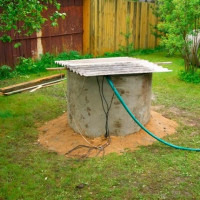 A do-it-yourself well in a country house: a guide for arranging a typical well from rings
A do-it-yourself well in a country house: a guide for arranging a typical well from rings 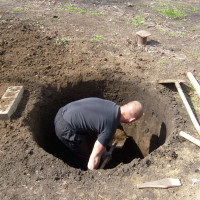 Digging a well with your own hands: types of well structures + an overview of the best digging technologies
Digging a well with your own hands: types of well structures + an overview of the best digging technologies 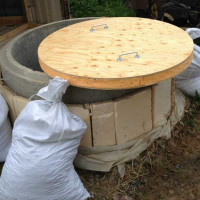 Do-it-yourself well warming for the winter: an overview of the best materials and methods of warming
Do-it-yourself well warming for the winter: an overview of the best materials and methods of warming 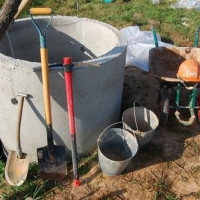 Do-it-yourself deepening of the well: a review of the best methods to get to the aquifer
Do-it-yourself deepening of the well: a review of the best methods to get to the aquifer 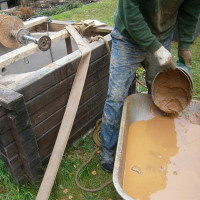 Do-it-yourself well cleaning: a review of the best preventative and capital methods
Do-it-yourself well cleaning: a review of the best preventative and capital methods  How much does it cost to connect gas to a private house: the price of organizing gas supply
How much does it cost to connect gas to a private house: the price of organizing gas supply  The best washing machines with dryer: model rating and customer tips
The best washing machines with dryer: model rating and customer tips  What is the color temperature of light and the nuances of choosing the temperature of the lamps to suit your needs
What is the color temperature of light and the nuances of choosing the temperature of the lamps to suit your needs  Replacement of a geyser in an apartment: replacement paperwork + basic norms and requirements
Replacement of a geyser in an apartment: replacement paperwork + basic norms and requirements
Digging a well myself, I’ll tell you this is not as easy as it might seem at first glance. I just thought so myself, and in the end I regretted it much better if I ordered a brigade. You encounter the first difficulties when you start digging at a depth of 5-6 meters, raising the ground with buckets, this is hellish work. We dug a well of 14.5 meters - I cursed everything in the world.
They built a well with a brother in the middle of this summer. It took us a lot of time to decide on a place. The layout also lasted long enough. We dug a well 12-13 meters deep with our own hands, I can say that this is very hard work. With all the rest, there were no difficulties. I advise you to take a very responsible approach to construction and do not spare time for planning.
I thought I meant digging a well in a summer cottage. I thought I’ll take it as my brother’s assistants, read the recommendations on the Internet, watch a video and dig it out somehow. But how I found out how hard this work was, I immediately did not want to manually dig it. Moreover, I can drive a tractor from work almost for free. I wonder if digging with a tractor has any significant disadvantages?